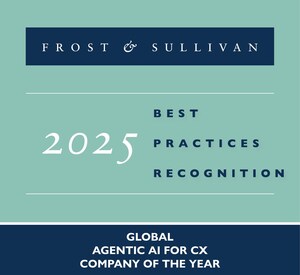
Frost & Sullivan Releases the "2025 Global Blockchain Mining Machine Industry White Paper", Analyzing the Development and Future Opportunities of the Global Blockchain Mining Machine Market
SHANGHAI, Nov. 17, 2025 /PRNewswire/ -- In recent years, with the acceleration of global digital transformation, blockchain technology has rapidly evolved into a critical component of modern economic systems. From financial and industrial applications to digital assets, blockchain's application scenarios are continually expanding, fueling the rise of decentralized economic models. within this transformation, blockchain hardware plays a foundational role, ensuring the efficiency and security of blockchain networks. The release of the "2025 Global Blockchain Mining Machine Industry White Paper" by Frost & Sullivan aims to provide industry stakeholders with in-depth market insights, revealing key trends and future opportunities in the sector.
The white paper covers not only innovations in cryptocurrency mining hardware but also delves into the future of blockchain technology in emerging fields such as AI computing and quantum computing. Through comprehensive global market analysis and authoritative data, the report offers invaluable strategic guidance for industry participants and investors, helping them seize opportunities in the highly competitive blockchain mining machine market.
1. Overview of Global Blockchain and Cryptocurrency Industry
1.1. Introduction of Blockchain
Blockchain is a decentralized data management and value transfer system built upon Distributed Ledger Technology (DLT). Its core mechanism lies in the use of cryptographic algorithms to encapsulate data into sequential "blocks," which are then linked through hash functions to form a continuous and tamper-resistant "chain" of information. This structure ensures the integrity, security, and chronological order of data during its creation and transmission. Within a blockchain network, all nodes operate without reliance on a central authority, achieving consensus through algorithmic protocols that verify and synchronize transaction records across the distributed ledger. This enables a system characterized by decentralized storage, immutability, traceability, and transparent information sharing. Fundamentally, blockchain represents an institutional innovation that replaces traditional trust intermediaries with algorithmic trust. It establishes a reliable foundation for multi-party collaboration and provides the technological infrastructure for secure value exchange, digital identity verification, and smart contract execution in the digital economy.
1.2. Introduction of Cryptocurrency
Cryptocurrency is a form of digital asset built upon blockchain technology and cryptographic principles. Its fundamental characteristic lies in decentralized issuance and management, meaning it operates without reliance on central banks or traditional financial institutions. Instead, transactions are verified and recorded through a distributed ledger maintained collectively by network nodes under a consensus mechanism. Each transaction is secured by encryption algorithms, ensuring data integrity, anonymity, and immutability. Beyond functioning as a medium of exchange and store of value, cryptocurrencies also serve as incentives and governance instruments within applications such as smart contracts and decentralized finance (DeFi). Representative examples include Bitcoin and Ethereum, which together form the trustless value transfer infrastructure underpinning the broader digital economy.
2. Overview of Global Blockchain Hardware Industry
2.1. Definition and Value Chain of Blockchain Hardware
The blockchain hardware industry refers to the complete industrial ecosystem that provides physical device support for blockchain technologies and applications. It encompasses hardware facilities used for blockchain network operation, data storage, computational processing, and security assurance. This industry spans from underlying computing and storage equipment, mining hardware, and dedicated cryptographic chips to auxiliary networking devices, supporting high performance, robust security, and scalability of blockchain systems.
The blockchain hardware value chain includes upstream core components and semiconductor supply, midstream hardware manufacturing and system integration, downstream deployment and operation, and peripheral support in security, energy, and compliance. Upstream provides computing foundations, while midstream ensures performance and reliability. In the midstream, hardware suppliers, such as Canaan (NASDAQ: CAN), which was the first Bitcoin mining hardware company to go public and ranked second in terms of computing power sold among all ASIC-based bitcoin mining hardware manufacturers in 2024 and the first half of 2025. In addition, downstream realizes commercial value, and the peripheral layer secures system stability, forming a complete ecosystem.
2.2. Introduction of Blockchain Mining Machine
A blockchain mining machine is a computer device specifically used for cryptocurrency mining. It maintains the security of the blockchain network by performing complex computational tasks, verifying the authenticity of transaction records, and obtaining network rewards in return.
The main customers of mining machines are still 2B-oriented, mainly including large-scale mining farms and institutional investors. These customers usually purchase a large number of mining machines for large-scale cryptocurrency mining to obtain greater benefits. There are also some 2C customers in the mining machine market, mainly individual miners. Some mining machines with low power consumption and quiet design have reduced the technical and financial thresholds for individuals to enter the mining field, making it possible for individuals and small-scale miners to engage in mining.
2.3. Cost Structure and Profitability of Mining Machine
Take the ASIC mining machine as an example, the single biggest cost and strategic lever in a Bitcoin miner is the ASIC chip, which ultimately dictates hash rate, joules-per-terahash, thermal headroom, and how fast a product line can iterate. Real competitiveness comes from choices around foundry node, wafer pricing and yields, binning, and package/test, all of which drive COGS volatility. Around the silicon, power delivery and thermal design determine whether rated efficiency holds up in real farms, while board stack-up, control firmware, and autotuning shape stability, uptime, and fleet manageability. Vendors compete as much on supply-chain reliability (wafer allocation, lead times, field failure rates, and warranty logistics) as on headline specs. In short, winners' pair leading silicon with disciplined PCB/control/cooling engineering to deliver predictable efficiency at scale.
The profitability of a mining machine is influenced by three major factors: bitcoin price, network hash rate, and electricity price. Bitcoin price is the most significant driver, as changes in its market value directly impact the monetary worth of mining rewards, with price movements proportionally affecting overall revenue and profit margins. Network hash rate also plays a crucial role; as the global network's computing power grows with more miners participating, an individual miner's share of total network capacity decreases, reducing the proportion of blocks they can mine and thus lowering their daily cryptocurrency earnings. Additionally, electricity price is a critical cost management factor, since energy consumption constitutes a large portion of operational expenses, so fluctuations in electricity rates directly affect total costs, with higher prices squeezing profit margins and vice versa.
3. Market Trends of Blockchain Mining Machine Industry
- Expansion into Home and SMB Miniature Mining Solutions
In recent years, a notable trend in blockchain mining equipment has been its penetration from large-scale mining farms into home and small-to-medium enterprise settings. This shift is driven by both technological advancements and diversifying market demands. For individual home users, the ideal mining rig prioritizes quiet operation, ease of use, and compatibility with home environments. By combining near-industrial hash rates with silent operation and simple plug-and-play installation using common home voltages, these miners make powerful cryptocurrency mining accessible for the first time in residential settings.
Innovative products utilize waste heat generated from mining for home heating, creating a dual-benefit model. This not only enhances the comprehensive utilization efficiency of energy but also significantly reduces the net energy cost of mining, making home mining more economically viable. By capturing this waste heat for space heating, the effective net energy cost of mining is drastically reduced. The cost of electricity for mining is partially or fully offset by the savings from not using a traditional heating system. This makes mining profitable at higher electricity price points than would otherwise be feasible.
The rise of Home and SMB miniature mining solutions signifies a pivotal democratization and maturation of the blockchain mining industry. Technological advances have successfully miniaturized professional-grade hardware into accessible, quiet, and efficient consumer products. Companies like Canaan (NASDAQ: CAN) are pioneering and leading the way in delivering consumer-grade mining solutions tailored for home users and SMEs. Additionally, the integration of heat utilization is a revolutionary step, transforming mining from a pure cost-center into a potential dual-revenue (crypto + energy savings) appliance for the household. In the future, this trend is expected to accelerate, further blurring the lines between consumer electronics and blockchain infrastructure, and opening up the ecosystem to a much broader global audience.
- Efficiency Escalation and Operational Cost Optimization
Innovations in ASIC chips have propelled the industry into a new era characterized by low power consumption and high computational power. Combined with synergistic upgrades in cooling systems and supporting hardware, these advancements have collectively fueled a leapfrog growth in the network's total computing power. This innovation directly translates into exceptional energy efficiency, with the latest mining hardware achieving remarkable performance metrics. The outcome of this hardware upgrade has been the Bitcoin network's sustained explosive growth in total computing power, soaring from approximately 100 EH/s in 2020 to over 900 EH/s by mid-2025.
Electricity costs typically make up 60% to 80% of total Bitcoin mining expenses, so optimizing energy strategies has become a core market driver for the mining machine industry, directly boosting miners' profitability. Relocating facilities to low-cost electricity regions is a mainstream tactic. Large-scale use of renewable energy also plays a key role, with hydropower, wind, and solar now powering over half of global mining. These strategies, along with waste heat recovery and AI tools to optimize real-time energy use, not only lower operational costs but also shape mining machine innovation, favoring rigs with low energy use and flexibility for diverse energy setups.
The dual forces of efficiency escalation and operational cost optimization are fundamentally reshaping the Bitcoin mining industry. The continuous advancement in technology has improved hardware efficiency and promoted the continuous upgrading of Bitcoin mining machines. Simultaneously, the industry's strategic pivot toward low-cost energy regions and renewable sources not only sustains individual mining profitability but also propels the entire industry toward greater scalability and sustainability, ensuring its continued evolution in the face of rising network difficulty and evolving market conditions.
- Rise of Mining Hosting and Cloud Mining Services
The Bitcoin mining industry is becoming increasingly specialized. The rise of mining rig hosting and cloud mining services has significantly lowered the barrier to entry, emerging as a key market driver propelling the growth of the mining hardware industry. Mining hosting is a service model in which the customer retains ownership of the miners while the operator furnishes the facility, low-cost electricity, and round-the-clock maintenance to keep the hardware hashing. Cloud mining is a lease-based model where customers rent a defined quantity of hash power, bypassing the purchase, transport, and upkeep of physical rigs and receiving daily BTC proceeds directly to their wallets.
The rise of mining hosting and cloud mining services directly stimulates demand for mining rigs by dramatically lowering participation barriers. Hosting services create a reliable customer base for hardware manufacturers by enabling individuals and institutions to own equipment without operational complexities, particularly driving demand for the latest high-efficiency ASICs. Simultaneously, cloud mining platforms function as large-scale institutional buyers, purchasing hardware to support their hash rate offerings, thus providing stable bulk orders for manufacturers. Together, these models establish a powerful symbiotic ecosystem: they democratize access to mining while ensuring continuous hardware upgrades, directly fueling both the technological advancement and commercial expansion of the Bitcoin mining hardware market.
The abovementioned content is just the illustration of the White Paper. The above-mentioned content is just the illustration of the White Paper. For the full report, please click the link as following: https://www.frostchina.com/content/insight/detail/6916e64468ba7f00814c2209
SOURCE Frost & Sullivan







Share this article